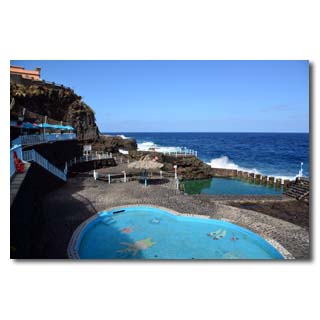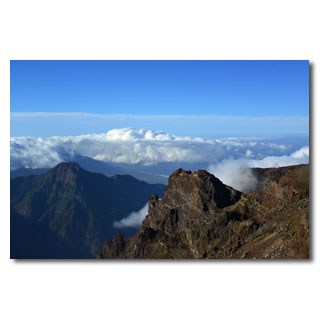San Andres y Sauces - middle centre in the northeast
While the village of San Andres is peacefully situated directly on the coast, the real centre of the municipality of Los Sauces with the 16th century church Montserrat, which overlooks everything, holds Flemish art treasures and whose forecourt is often used for a chat and a small meal. Opposite the church square is another plaza in the shape of the park Antonio Herrera decorated with large araucaria and other tropical plants.
Those who would like to take a bath can do so in the easily accessible sea bath with its protected seawater pool for all ages. There is also a restaurant here and a few minutes away the new harbour of San Andres with its sandy beach invites you to sunbath in absolute peace.
With around 4,500 inhabitants, the municipality is the centre for the villages of Los Gallegos to Puntallana and is easy to reach via the newly built connecting road.

The centre of Los Sauces with the 16th century church'Montserrat

The park 'Antonio Herrera' in the centre of Los Sauces with the town hall…

... and tropical planting.

The sea swimming pool 'Charco Azul' invites to a well protected bath in any weather…

... or also for dinner with a wonderful view of the Atlantic.

Only the sound of the waves can be heard…

... if you go to the neighbouring'Puerto Espindola'…

... you will also find a completely lonely beach.

Roque de Los Muchachos
The 'Roque de los Muchachos' at 2.426 m is the highest elevation of La Palma and hosts the most important international observatory of the northern hemisphere. Here is a real high mountain climate, in winter the 'Roque', as the locals call it, is often covered with a snow or ice cap. The observatory is the cause of the only light protection law in the world that exists on La Palma and because of which we are protected from neon or laser advertising. On the Roque you will not only find what is currently (2013) the world's largest reflector telescope with a diameter of 10,40 m; it is also the starting point for many hiking trails through impressive rock formations and the most diverse climatic zones. From the roof of the island you can usually see the neighbouring islands of Tenerife (with Spain's highest mountain, the Teide), as well as La Gomera and El Hierro. A visit is worthwhile at all seasons, in winter, however, you should pay attention to the signs that indicate the obligation to use snow chains if necessary.

The highest point of the Roque - old volcanic vents defying wind and weather

Even closer to the stars - view from the Roque into the Aridane valley…

... to the whole splendour of the Milky Way…

… El Paso …

... or to Polaris and the village El Tablado.

Crystal clear air in the morning sun

The domes of the telescopes, landmarks of the Roque

High-tech in an archaic environment

Changing the watch between the sun and moon

Fastest adjustable reflector telescopes

Landmarks visible from afar, seen from El Tablado

Raging cloud formations

barren high mountain vegetation

View into the Aridane valley

Staggered mountain ranges

Tuff and basalt, building material La Palmas

Columned basalt, once formed at great depths under the sea floor, now at lofty heights.

Cloud falls and rich rock colours

The neighbouring island of Tenerife 'above the clouds'

Botanical experimental fields in the high mountains

And again and again fascinating and rapidly changing wok formations

... enjoy …

... and experience.

View to Breña Alta

The Teide, Spain's highest mountain

The broom glows in the evening sun

Between tree line and vegetation-free zone enchants a broom with bright color

And once again we are above the clouds

© 2012 by Bernd y Nadja Blume. Copias de los textos o fotos, igual que sean digital o imprimido sólo son permitido con la licencia por escrito de los autores.